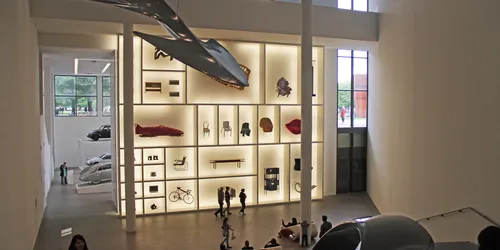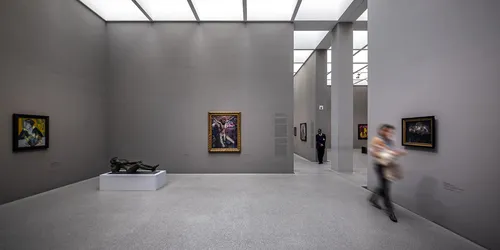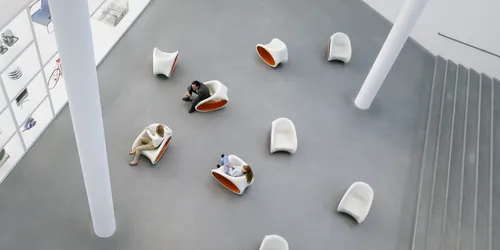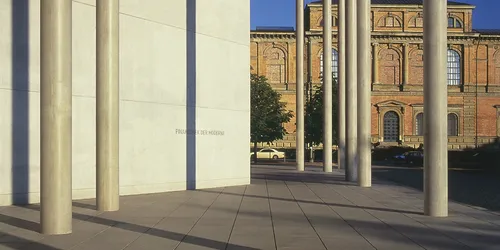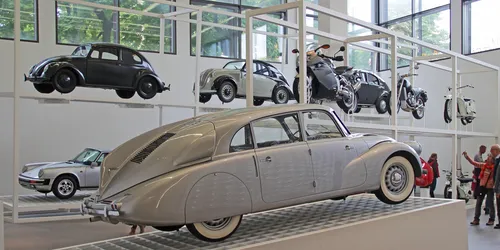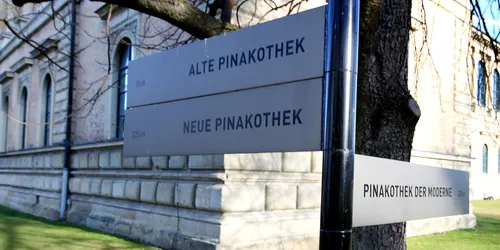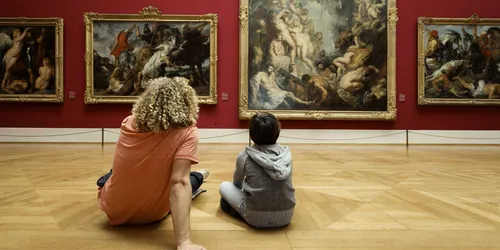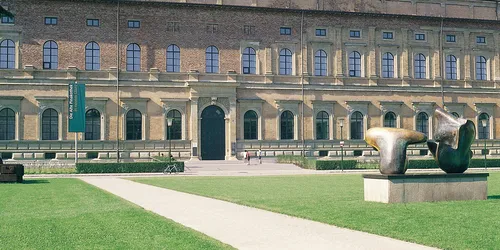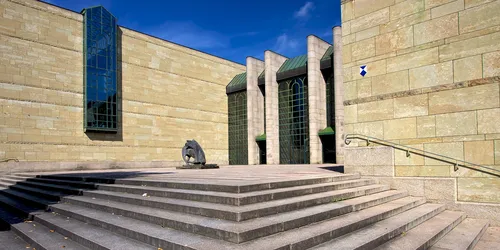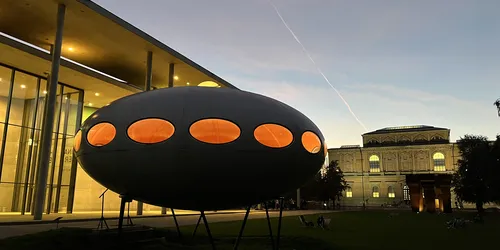Pinakotheken in Munich: Discover art
On a walk through the Kunstareal Munich, we follow in the footsteps of King Ludwig I and explore the important art collections of Bavaria's museums along the way. From the main railway station, our tour takes us across Königsplatz to the large Pinakothek museums and back again via the Old Botanical Gardens. Discover the magnificent exhibitions in Munich's Pinakothek museums by train now!
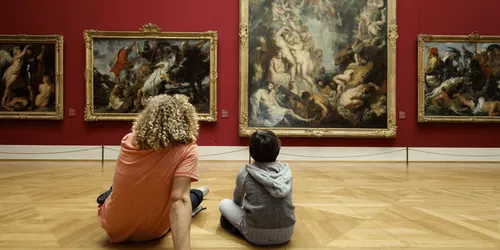
Munich is always worth a trip by train. Rich in history, the Bavarian capital offers a diverse range of art and culture. The number of cultural institutions such as museums and universities is particularly dense, especially in the Kunstareal München. This is located in the Maxvorstadt district of Munich, north of the main railway station, and is one of the most important cultural centres in Europe. It is also home to THE sights of the state capital - the Munich Pinakothek museums.
What exactly are the Pinakothek museums in Munich?
In ancient times, the term "Pinakothek" referred to the room in a temple where panel paintings were kept. A Pinakothek is therefore to be understood as a picture gallery. In German-speaking countries, the use of the term goes back to King Ludwig I of Bavaria, who founded the Alte and Neue Pinakothek in Munich. A tip first: don't try to visit all the museums mentioned in one day. Just one Pinakothek is enough to fill the programme for a day trip to Munich. But let's start with our walk through the entire Kunstareal before focussing specifically on the exhibitions in Munich's Pinakothek museums. We start at the main railway station.
From Bahnhofplatz, the route takes us northwards into Luisenstraße. We pass the Staccioling, an oversized modern sculpture on Karl-Stützel-Platz. After a few hundred metres, we catch sight of the first monumental building - the Propylaea. This gate, which is modelled on a temple entrance, or more precisely the Propylaea of the Acropolis, was once commissioned by King Ludwig I. Built between 1848 and 1862 according to plans by Leo von Klenze, the Propylaea served only as a representative city gate, as the city had already expanded beyond Königsplatz during the construction period.
Kunstareal Munich: at the centre of the "Isar-Athens"
On our way through the Kunstareal in Munich, we now walk through the gate and find ourselves on Königsplatz. This central Munich square with imposing buildings on three sides impresses with its European classicist style. On the north side of Königsplatz is the Glyptothek, a museum also built under Ludwig I for the collection of ancient sculptures. In the museum, whose façade is reminiscent of a Greek temple, you can marvel at sculptures, mosaics and reliefs from antiquity. Opposite, on the south side of Königsplatz, is the former art and industrial exhibition building, which has housed the State Collections of Antiquities since 1967. During a visit to the museum, you can expect to see ancient objects of art and utility in the form of clay vessels, statuettes, gold jewellery and glass. Tickets for both museums can be purchased as a combination directly at the museum ticket offices or online in advance. The inner courtyard and Hall VIII of the Glyptothek also house a museum café where you can enjoy Munich's Mediterranean atmosphere over a cup of Italian coffee.
Art from the Middle Ages to the 19th century
We leave Königsplatz in an easterly direction and follow Brienner Straße to Karolinenplatz. A black obelisk rises up in the centre of the square to commemorate the Bavarian soldiers of the Russian campaign of 1812. However, we continue our walk northwards into Barer Straße. After a few metres, we cross Gabelsberger Straße and see the Alte Pinakothek on our left. The Alte Pinakothek opened its doors in 1836 and was the largest museum building in the world at the time. Paintings from the Middle Ages to the mid-18th century are waiting to be discovered during your visit to the art museum. In addition to a self-portrait by Albrecht Dürer from 1500, the Alte Pinakothek also houses works by Pieter Bruegel the Elder, Peter Paul Rubens and Rembrandt. Original paintings by Raphael and Da Vinci, such as the "Madonna with the Carnation", are also on display here. Be sure to plan enough time to enjoy the time-honoured masters.
The next stop on our tour of Munich's Kunstareal is directly opposite the Alte Pinakothek. With its collection, the Neue Pinakothek follows on chronologically from the Alte Pinakothek and is itself supplemented by the Pinakothek der Moderne with exhibits from more recent art history. Munich's art museum, which opened in 1853, was badly damaged in air raids in 1944 and completely burnt out. In 1973, the new Pinakothek reopened its doors in its postmodern new building. During a visit, you can expect to see mainly European paintings and sculptures from the 19th century - from Classicism, Romanticism and Art Nouveau to Impressionism. In addition to Caspar David Friedrich, a representative of German Romanticism, the Neue Pinakothek also exhibits works by Manet, Klimt, Monet and Van Gogh. The Neue Pinakothek gallery is expected to undergo extensive refurbishment work until 2025 and will not be open to the public. A selection of its masterpieces has been moved to the ground floor of the east wing of the Alte Pinakothek and to the Schack Collection in Prinzregentenstraße, not far from the Bavarian National Museum, for the duration of the construction work. On the Pinakothek website, however, you have the opportunity to marvel at the 22 rooms and ten cabinets of the Neue Pinakothek on an online tour.
Contemporary art in the Kunstareal in Munich
The next stop on our walk through Munich's Kunstareal is the Pinakothek der Moderne in Munich. The museum building, which opened in 2002, is located opposite the Alte Pinakothek to the east. The Pinakothek der Moderne unites four independent museums under one roof and thus covers four different disciplines - art, graphics, architecture and design. The Modern Art Collection, part of the Bavarian State Painting Collections, focuses on paintings and sculptures from classical modernism to contemporary art. During your visit, you can marvel at paintings by Max Ernst, Joan Miró, Salvador Dalí and Andy Warhol. The graphic arts section is covered by the Staatliche Graphische Sammlung München. This museum for drawings and prints has around 400,000 sheets from the 12th to the 21st century in its repertoire. The four independent museums are complemented by the Architecture Museum of the Technical University of Munich and Die Neue Sammlung. The latter is a design museum that is one of the world's largest museums of 20th and 21st century applied art. As in all Pinakothek museums, there are regular guided tours for those interested in delving deeper into art history.
For art-loving families, the Pinakothek der Moderne also offers a special programme for children and young people. Workshops, museum tours for the whole family and interactive events introduce even the youngest visitors to the subject of art in a playful way and allow them to get creative themselves. If you get hungry from all the impressions, the Pinakothek der Moderne's conservatory is the perfect place to take a break. The adjoining café serves coffee and cake as well as small snacks to keep you going.
In addition to the Pinakothek museums in Munich, there are many other impressive museums in the Kunstareal in Maxvorstadt or in the immediate vicinity. One of them is the Brandhorst Museum. It houses Udo and Anette Brandhorst's collection of modern and contemporary art. As you walk past, the spectacular museum façade made of 36,000 ceramic rods immediately catches the eye. However, we gradually make our way back to the main railway station on our tour of Munich. We follow Gabelsberger Straße westwards, past the impressive building of the University of Television and Film. Inside, there is still the State Museum of Egyptian Art with exhibits from all eras of Ancient Egypt to discover. However, we turn south into Arcisstraße and follow it until we reach the neoclassical building of the Park Café on the northern edge of the Old Botanical Gardens.
After the Pinakotheken in Munich: a break in the park
This botanical garden, which was converted into a city park in 1937 by landscape architect Friedrich Ludwig von Sckell, not only invites you to take a stroll, but the Park Café also offers the opportunity to treat yourself to a short break with a coffee or a freshly tapped speciality beer. The restaurant serves both pub classics and freshly grilled specialities, and in fine weather the large terrace with adjoining beer garden invites you to linger. After our little refreshment, the path through the Old Botanical Garden leads us past the original entrance portal from 1812 in the eastern part of the park. Following Elisenstraße to the west, we pass the Neptune Fountain and turn south again at Luisenstraße to Bahnhofplatz.
Our walk to the Pinakotheken in the Kunstareal Munich was rich in different cultural impressions. Nevertheless, you should definitely come back, as there are a total of 18 museums and exhibition spaces as well as 40 galleries and cultural institutions to explore in the Kunstareal Munich alone. And the Pinakothek museums with their changing special exhibitions will always let you discover something new. Another tip: on Sundays, the Pinakothek museums, along with a number of other museums in Munich, offer discounted admission of €1. Your next trip to Munich by train will almost plan itself. See you next time.
Special exhibitions
Arrival
Barer Straße 27
80333 Munich
München Hbf Haupthalle
Our tip: Please make sure to check your train connection and the expected capacity before you start your journey.
